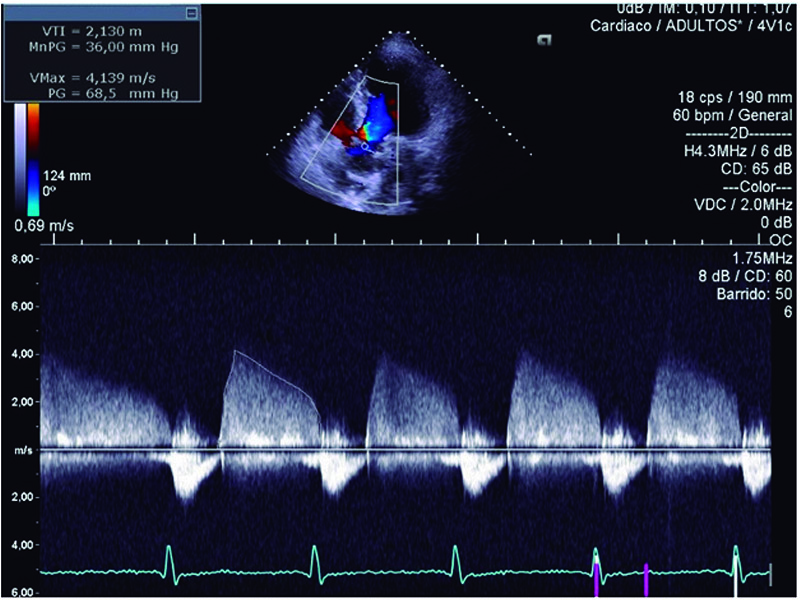Volume 115, Nº 2, August 2020
DOI: https://doi.org/10.36660/abc.20190243
ORIGINAL ARTICLE
Velocity-Time Integral of Aortic Regurgitation: A Novel Echocardiographic Marker in the Evaluation of Aortic Regurgitation Severity
José Abellán-Huerta
Juan Carlos Bonaque-González
Ramón Rubio-Patón
José García-Gómez
Santiago Egea-Beneyto
Federico Soria-Arcos
Luciano Consuegra-Sánchez
Rosa María Soto-Ruiz
José Luis Ramos- Martín
Juan Antonio Castillo-Moreno

Figure 1 – Measurement of the velocity-time integral of aortic regurgitation flow from the apical 5-chamber view. MnPG: mean pressure gradient; PG: maximum pressure gradient; Vmax: maximum aortic regurgitant flow velocit y; VTI: velocity-time integral of aortic regurgitation.
Abstract
Background: Echocardiography is essential for the diagnosis and quantification of aortic regurgitation (AR). Velocitytime integral (VTI) of AR flow could be related to AR severity.
Objective: This study aims to assess whether VTI is an echocardiographic marker of AR severity.
Methods: We included all patients with moderate or severe native AR and sinus rhythm who visited our imaging laboratory from January to October 2016. All individuals underwent a complete echocardiogram with AR VTI measurement. The association between VTI and AR severity was analyzed by logistic regression and multivariate regression models. A p-value<0,05 was considered statistically significant.
Results: Among the 62 patients included (68.5±14.9 years old; 64.5%: moderate AR; 35.5%: severe AR), VTI was higher in individuals with moderate AR compared to those with severe AR (2.2±0.5 m vs. 1.9±0.5 m, p=0.01). Patients with severe AR presented greater values of left ventricular end-diastolic diameter (LVEDD) (56.1±7.1 mm vs. 47.3±9.6 mm, p=0.001), left ventricular end-diastolic volume (LVEDV) (171±36.5 mL vs. 106±46.6 mL, p<0.001), effective regurgitant orifice (0.44±0.1 cm2 vs. 0.18±0.1 cm2, p=0.002), and regurgitant volume (71.3±25.7 mL vs. 42.5±10.9 mL, p=0.05), as well as lower left ventricular ejection fraction (LVEF) (54.1±11.2% vs. 63.2±13.3%, p=0.012). The VTI proved to be a marker of AR severity, irrespective of LVEDD, LVEDV, and LVEF (odds ratio 0.160, p=0.032) and of heart rate and diastolic blood pressure (DBP) (odds ratio 0.232, p=0.044).
Conclusions: The VTI of AR flow was inversely associated with AR severity regardless of left ventricular diameter and volume, heart rate, DBP, and LVEF. VTI could be a marker of AR severity in patients with native AR and sinus rhythm. (Arq Bras Cardiol. 2020; 115(2):253-260)
Keywords: Heart Failure; Aortic Valve Insufficiency/diagnosis,imaging; Echocardiography, Doppler/methods.















